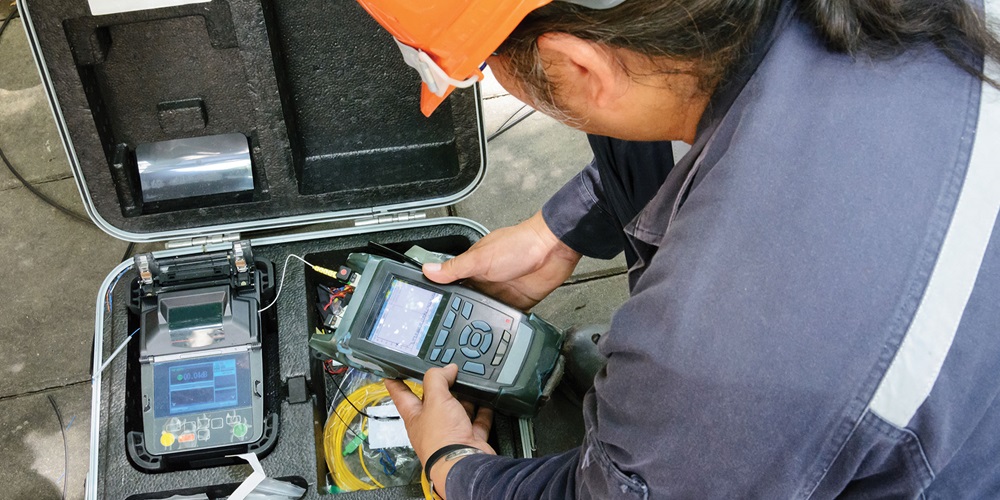Revealing the Trick Uses of Optical Fibre Testing for Reliable Information Transmission
In the world of contemporary communication, optical fiber screening arises as an important technique for maximizing information transmission. Comprehending the diverse applications of optical fibre testing welcomes a much deeper exploration into its critical function in shaping the future of information interaction.

Value of Optical Fibre Screening
The importance of optical fiber screening can not be overstated, as it serves as a crucial part in making certain the dependability and performance of information transmission systems. In an age where high-speed communication is critical, any type of deficiencies in fiber optics can bring about substantial data loss and reduced efficiency. Strenuous testing methods are necessary to confirm the integrity and performance of optical cables.
Examining permits the recognition of issues such as micro-bends, macrobends, and splice losses that can impede signal top quality. Additionally, it provides insights right into the general depletion and data transfer capacities of the fiber, ensuring that the network satisfies certain functional standards. Regular testing not just enhances system performance but also extends the life-span of the framework by identifying potential issues before they intensify into pricey failures.

Kinds Of Optical Fiber Examinations
Numerous kinds of optical fibre tests are performed to make sure the performance and integrity of fiber optic networks. These examinations can be categorized into several essential kinds, each serving a specific objective in assessing the integrity of the fiber.
First, Optical Time Domain Name Reflectometry (OTDR) is a famous examination that recognizes faults, mates, and connectors within the fiber. By sending pulses of light and evaluating the mirrored signals, service technicians can identify issues along the fibre's size.
Second, insertion loss tests review the amount of signal loss when light travel through adapters or splices, which is important for preserving network performance.
Third, return loss examinations gauge the amount of light reflected back towards the source, offering understandings right into the quality of links and possible resources of interference.
Additionally, connection tests ensure that the fibre path is complete, allowing service technicians to confirm that the fiber is undamaged with no breaks. optical fibre testing equipment.
Last but not least, visual fault locators utilize noticeable light to recognize breaks or severe bends in the fibre, aiding in quick troubleshooting. Jointly, these examinations form a detailed approach to keeping optimum performance in fibre optic networks.

Applications in Network Upkeep
In contemporary telecoms, efficient network upkeep depends greatly on optical fibre screening to recognize and correct concerns promptly. Routine screening makes certain that the network operates at optimal performance levels, minimizing downtime and boosting user experience.
Among the main applications of optical fiber screening in upkeep is the discovery of mistakes, such as breaks, bends, or incorrect additional reading connections. Methods like Optical Time Domain Reflectometry (OTDR) enable technicians to find these problems precisely and analyze the top quality of the fiber web link. In addition, loss testing validates the stability of the optical path, ensuring that signal attenuation continues to be within appropriate restrictions.
Routine upkeep testing also helps in safety nets, determining potential troubles before they intensify right into considerable failures. This proactive method can save companies both time and funds. During upgrades or developments, optical fibre testing makes sure that brand-new installments integrate seamlessly with existing facilities.
Enhancing Data Transmission Dependability
Efficient network maintenance via optical fibre screening not only addresses immediate issues but likewise plays a significant role in boosting data transmission integrity. By determining mistakes, measuring signal loss, and analyzing the overall condition of fibre optic cables, screening guarantees that prospective troubles are corrected prior to they rise into considerable disturbances.
Routine optical fiber testing, such as time-domain reflectometry (TDR) and optical time-domain reflectometry (OTDR), enables service technicians to pinpoint the exact places of breaks, flexes, or port problems within the network. This proactive approach not only reduces downtime however likewise enhances the efficiency view it of data transmission by guaranteeing that the paths for signals are clear and operating efficiently.
Moreover, testing aids in validating adherence to sector criteria and specifications, which is crucial for maintaining the stability of data circulation. By ensuring that each link fulfills called for thresholds for loss and top quality, organizations can strengthen their self-confidence in the integrity of their data networks.
Eventually, spending in comprehensive optical fiber testing not just boosts information transmission dependability however likewise supports the long-term functional effectiveness of communication infrastructures.
Future Patterns in Fiber Testing
Emerging modern technologies are positioned to reinvent fibre screening, leading the method for enhanced efficiency and precision in data transmission diagnostics (robotic vision). As the need for faster internet and higher bandwidth remains to rise, the combination of sophisticated devices such as expert system (AI) and maker understanding (ML) is established to change standard fibre screening approaches. These technologies will make it possible for anticipating upkeep and automated fault detection, significantly lowering downtime and enhancing network dependability
Additionally, the adoption of investigate this site Web of Things (IoT) tools will promote real-time surveillance of fibre networks, permitting instant identification of efficiency concerns. This shift in the direction of proactive management will decrease interruptions and maximize information circulation.
In addition, innovations in optical time-domain reflectometry (OTDR) and brand-new screening criteria will boost the precision of dimensions, ensuring that data integrity is kept throughout the transmission procedure. The development of 5G technology likewise necessitates the growth of more innovative fibre screening methods to sustain its high-speed needs.
Verdict
To conclude, optical fiber screening is essential for keeping effective data transmission within communication networks. By employing various testing strategies, such as OTDR and insertion loss tests, possible faults can be identified and fixed, consequently boosting signal clearness and decreasing downtime. Routine testing not only makes sure conformity with sector standards however likewise helps with aggressive maintenance, eventually adding to the long-lasting dependability and performance of fibre optic systems. The continued evolution of screening techniques will certainly further bolster these capabilities in the future.